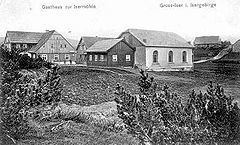Elevation 840 m | ||
 | ||
Groß Iser is a village on Hala Izerska existing from the 17th century until 1945. Today the remains of the village can be found in Poland just by the Czech border (marked here by the Jizera river). The closest towns are Świeradów Zdrój on the Polish side and Harrachov on the Czech side.
Contents
- Map of GroC39F Iser Poland
- The beginnings
- The period of highest development
- Pacification of the village
- Life of the settlers
- References
Map of Gro%C3%9F Iser, Poland
The beginnings
In 1630 the first person settled on Hala Izerska. It was a Czech Evangelical refugee named Thomas. Then a hut for forest workers was built there and thus the village started. The development was slow, as the climate was harsh and the territories were mainly swamp. However, in the church chronicles in the neighbouring town of Świeradów we can find a note from 1742 saying that in Groß Iser 20 parishioners lived. On 09.09.1742 the first mass was said in the village (by a pastor from Świeradów).
The period of highest development
In the 19th century the village became popular among the visitors of the health resort in Świeradów, which caused fast development of the settlement. Tourists would visit the village in spring and summer on foot, in winter on cross-country skis. Besides, peat bog from the surrounding moors was used in Świeradów for spa treatment. In the period of its greatest development 400 people lived in the village. There were 3 bars, mills, so called "church" (in fact a praying building or a chapel), 2 tourist huts (mainly for the health resort visitors), a café, 2 schools, a fire station, and 43 houses.
Pacification of the village
On May 10 or 10 October 1945 the Soviet army came in. They burnt the hunter’s hut and killed the village teacher. Between June and October 1945 the villagers were gradually displaced. The houses were destroyed one after another. The place, as located just by the border, was not popular and was soon forgotten. In the mid 1980s the remains of the village were discovered by a group of Polish students. The only not fully destroyed building (a school in the times of Groß Iser) has been turned into a students’ hut. It is now called "Chatka Górzystów" (the mountain people’s hut) and it offers sleeping places as well as hot meals.
Life of the settlers
The settlers lived a poor life here. They earned their livings by fishing (trout mainly), keeping sheep and cattle, as well as producing cheese and wool. Men also worked in the woods, cutting the trees. Some of them were poachers. Today, the three people living there are the caretakers of the students' hut, along with their daughter.
